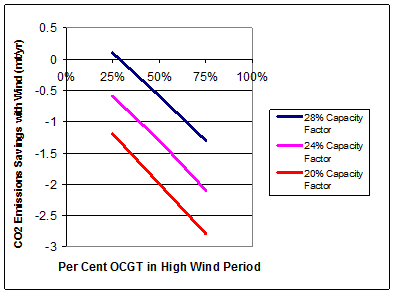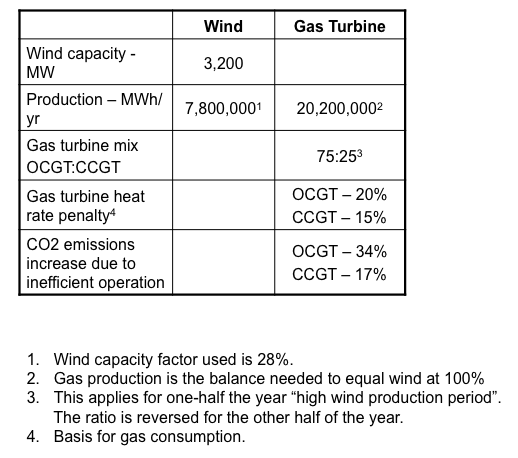A system with renewables that uses LM6000 turbines for fill-in power achieves 76−79% of the expected CO2 emissions reductions and 20−45% of the expected NOx emissions reductions. An emissions displacement analysis would have overestimated emissions reductions by 23% for CO2 emissions and by 55−80% for NOx emissions. Similar penalties of 24% are incurred for 501FD CO2 emissions reductions, but NOx emissions increase by factors of 2−6 times the amount emissions were expected to be reduced, because of the unoptimized NOx performance of the 501FD system below 50% power.Peter Lang noted that there are two types of natural gas powered generators:
Open Cycle Gas Turbine (OCGT) and Combined Cycle Gas Turbine (CCGT). OCGT has lower capital cost, higher operating costs, uses more gas and produces more greenhouse emissions than CCGT per MWh of electricity generated. OCGT follows load changes better than CCGT. OCGT produces electricity at less cost than CCGT at capacity factors less than about 15% (ie 15% of the energy it would produce if running full time at full power). CCGT has higher capital cost and needs to run at higher power and run for longer to be economic. CCGT is more efficient so it uses less gas and produces less greenhouse emissions. CCGT produces electricity at less cost than OCGT for capacity factors above about 15%.Of the two CCGT emits 0.577 tons of CO2 per MWh of electrical generation, while OCGT emitts 0.751 tons of CO2 per MWh. (See here p. 136) Coal emits about 0.86 to 0.88 tons of CO2 per MWh. THE AWEO claims:
The average CO2 emission saved by wind is about 0.58 t CO2/MWh.But that figure assumed that wind displaced natural gas and coal in proportion to their percentage of the generation mix.
Lang found that some forms of natural gas generation were more likely to be displaced than others, however.
If wind generation is available the power produced is highly variable and unscheduled so it needs to be backed up by OCGT. Although OCGT is called up to back up for wind, the energy produced by wind actually displaces CCGT generation mostly.Assuming OCGT backup, Lang calculated that wind saved 0.058 tons of CO2 per MWh. CCGT is unsuitable for wind backup because it lacks the flexibility that OCGTs have. OCGT can ramp up from zero generation for full power in a short period of time, thus along with hydro, OCGTs compliment wind. But that complimentary relationship comes at a cost Thus Lang's conclusion is that wind, if backed up by natural gas is far less capable than nuclear power in preventing CO2 emissions.
The University of Sidney's figures for CO2 emissions from natural gas were higher than most sources. I assume that those figures included methane loss from natural gas processing and transmission, and from combustion inefficiencies, but Lang inferred CO2 emissions from natural gas turbines that closely tracked conventional assumptions in the Royal Academy of Engineering report. Those numbers were .400 kg of CO2 per kWh from CCGTs and .533 kg of CO2 from OCGTs. Lang then calculated the CO2 emissions avoided by using wind as 0.09 kg per kWh generated by wind. Lang's paper was posted on Barry Brook's blog Brave New Climate and drew 169 responses. Criticisms focused on Lang's assumption of natural gas backup. It was augued that hydro backup would lead to improved wind carbon reduction performance, and indeed it would. But Lang's critics appeared to make unrealistic assumptions about the avaliability and cost effectiveness of hydro backuo including pumped storage.
Thus Lang's findings and those of Katzenstein and Apt, raise significant, unanswered questions about the value of wind in a wind-natural gas system in mitigating carbon emissions. Peter Hawins supports those questions. Hawkins is a retired Electrical Engineer who is investigating wind performance, and indeed Hawkins appears to have enough to say about wind performance, that I probably will make his work the subject of a separate post.
Hawkins is very critical of published research that supports wind. Hawkins contends, as a result of his analysis of CO2 emissions savings that
the typical claims {by wind supporters] are not supported, except by ignoring most of the following considerations:Hawkins compares the typical claims with
The amount of wind mirroring/shadowing backup required.
Inefficient operation imposed on the mirroring/shadowing backup, in terms of both the fossil fuel consumption and CO2 emissions, treated separately.
The need to make comparisons, with respect to gas plants, of:
Case A – The more efficient Combined Cycle plants (CCGT) operating alone, in other words without the presence of wind, versus;
Case B – The appropriate mix of gas plant type used to balance wind’s volatile output. This includes the need to introduce less efficient, but faster-reacting, Open Cycle Gas Turbine gas plants (OCGT) to mirror/shadow the wind production, especially as wind penetration increases.
The effect of reduced wind capacity factor.
The effect of wind output exceeding 1-2 percentage points of a total electricity system, on a country or regional basis.

Hawkins relying on Katzenstein and Apt explains
The “Typical Claim Scenario”, which ignores the heat rate penalties, shows over 50,000 MMcf/yr savings assuming CCGT plants only. In this case, introducing OCGT, again without heat rate penalties, reduces the savings to about 30,000 MMcf/yr. Introducing heat rate penalties and using CCGT only produces savings of about 30,000 MMcf/yr as well, but the inclusion of OCGT plants reduces gas savings to almost zero.Hawkins offers this chart of the reality of wind-gas CO2 emissions abatement claims and and actual performance:
 Hawkins offers this explanation:
Hawkins offers this explanation: The “Typical Claim Scenario” shows annual savings of about 3 million tons of CO2 ignoring any OCGT considerations and any effect of heat rate penalties or the related CO2 emissions increase factor. Introducing OCGT within this scenario cuts the savings by more than one-half. Using the inefficiency factors and only CCGT shows that the CO2 savings are reduced by about one-third, but introducing OCGT drives the CO2 savings into the negative category.
Hawkins offers this analysis of the CO2 emissions performance of a wind-gas system:
Hawkins then offers this analysis of the relationship of wind penetration and the OCGT/CCGT ratio.
 Hawkins explains:
Hawkins explains: Again negative values represent increased emissions over CCGT plants operating alone. Reducing the OCGT component to 25 per cent at a 28 per cent wind capacity factor yields effectively zero CO2 emissions savings.Hawkins also observes:
The lower ranges for OCGT plants in the mix are likely not feasibleHawkins conclusion is:
Notwithstanding the nature of the calculator, robust inferences can be drawn from its results because the analysis captures a fuller range of considerations. The general conclusion is clear: industrial wind power does not produce the claimed benefits of reductions in fossil fuel consumption and CO2 emissions when up-and-down backup generation inefficiencies are taken into account.
It is clear then that Katzenstein and Apt, Lang and Hawkins have offered a formable challenges to the conventional wisdom about with CO2 emission savings from wind investments, and that investments in wind when coupled with natural gas backup appear to not be cost effective. Lang argues that investments in nuclear are 50 times more cost effective than an investments in wind. I am unaware of any effective challenge to these argument at the moment, and thus wind supporters must come to terms with it by offering effective critiques, if they are to loose their last shreds of intellectual respectability.










5 comments:
I'm glad to see that Carnegie Mellon maintains it's excellent credibility with a well thought out study as opposed to Stanford's Jacobson and his dreamworld by 2030.
Charles, I admire your persistent effort trying to point out the fallacies of solar/wind renewable power and educate public on this subject.
It is all clear to us engineers and we don’t need any persuasion that nuclear power is best, however, it is pointless talking about heat rates and other highly technical stuff to self proclaimed environmentalist yahoos or to folks who are completely lacking any technical knowledge. Those men and women have no clue about OCGT, CCGT, IFR, LFTR, Rankine cycle, Bryton cycle, etc, etc. Majority of people know nothing about the efficiencies in thermodynamic cycles, hence most people believe that when you burn natural gas you convert it 100% to electricity.
I found out that trying to teach some folks the complex realities in power generating systems is like trying to teach a dead horse ABC's, hopeless.
It is this hopelessly low level of public education on energy subject that has caused massive support for wind and solar energy because it is something the limited brain can comprehend, while such thinkers always fail to see the real realities in whole power system.
When all boils down to and when all renewable propaganda garbage is sifted through scrutiny sieve, nuclear power always comes to the top as the most environmentally friendly and economic power source.
Most power engineers knew this more than 50 years ago, hence I can proclaim with absolute certainty, supported by evidence, that nuclear power supporters are true environmentalists and humanists.
Nuclear power reaches far beyond environmentalism. It is the only base power source capable to sustain large global population in decent living conditions in post fossil fuel age.
The only thing that makes nuclear power plant construction expensive in USA, and few other countries, is a herd of lawyers paid by anti nuclear parasites with intentions to tangle up the project in unrelated legalese expenses until the owners go broke. So, unless you restrain these interference troublemakers on a 3/8 size industrial grade steel chain, like mad dogs, nothing will get done in our self destructive democracy. It means that populace will always vote for those who are better brain washers, outvoting those who are more intelligent.
Of late wind apologists are getting more and more shrill and seem to be grasping at straws to salvage what is left of their credibility
It's getting to the point where they are really engaging in special pleading. If the argument for wind was sound there would be no need for the sort of mathematical gymnastics they are indulging in.
Frank, I am committed to frequent posts. Posts on Wind frequently got good readership, even if they deal with technical issues. I am challenging orthodox beliefs, sometimes people are interested in why I do that. Anyway it works well enough for me to think it is worth while.
Keep up the good work, Mr. Barton. More and more people are becoming aware of this issue, and sites like Nuclear Green are essential as counterweights to wind propaganda.
Post a Comment